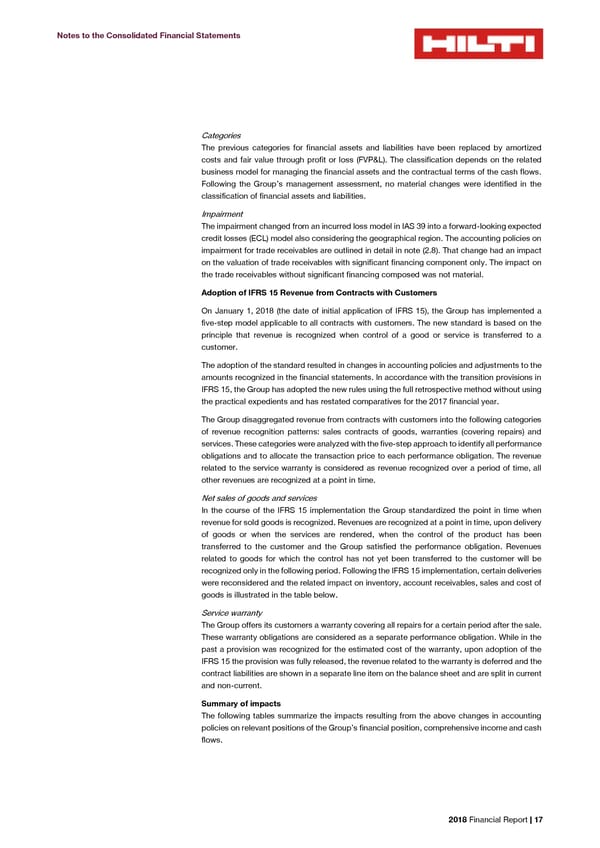Notes to the Consolidated Financial Statements Categories The previous categories for financial assets and liabilities have been replaced by amortized costs and fair value through profit or loss (FVP&L). The classification depends on the related business model for managing the financial assets and the contractual terms of the cash flows. Following the Group’s management assessment, no material changes were identified in the classification of financial assets and liabilities. Impairment The impairment changed from an incurred loss model in IAS 39 into a forward-looking expected credit losses (ECL) model also considering the geographical region. The accounting policies on impairment for trade receivables are outlined in detail in note (2.8). That change had an impact on the valuation of trade receivables with significant financing component only. The impact on the trade receivables without significant financing composed was not material. Adoption of IFRS 15 Revenue from Contracts with Customers On January 1, 2018 (the date of initial application of IFRS 15), the Group has implemented a five-step model applicable to all contracts with customers. The new standard is based on the principle that revenue is recognized when control of a good or service is transferred to a customer. The adoption of the standard resulted in changes in accounting policies and adjustments to the amounts recognized in the financial statements. In accordance with the transition provisions in IFRS 15, the Group has adopted the new rules using the full retrospective method without using the practical expedients and has restated comparatives for the 2017 financial year. The Group disaggregated revenue from contracts with customers into the following categories of revenue recognition patterns: sales contracts of goods, warranties (covering repairs) and services. These categories were analyzed with the five-step approach to identify all performance obligations and to allocate the transaction price to each performance obligation. The revenue related to the service warranty is considered as revenue recognized over a period of time, all other revenues are recognized at a point in time. Net sales of goods and services In the course of the IFRS 15 implementation the Group standardized the point in time when revenue for sold goods is recognized. Revenues are recognized at a point in time, upon delivery of goods or when the services are rendered, when the control of the product has been transferred to the customer and the Group satisfied the performance obligation. Revenues related to goods for which the control has not yet been transferred to the customer will be recognized only in the following period. Following the IFRS 15 implementation, certain deliveries were reconsidered and the related impact on inventory, account receivables, sales and cost of goods is illustrated in the table below. Service warranty The Group offers its customers a warranty covering all repairs for a certain period after the sale. These warranty obligations are considered as a separate performance obligation. While in the past a provision was recognized for the estimated cost of the warranty, upon adoption of the IFRS 15 the provision was fully released, the revenue related to the warranty is deferred and the contract liabilities are shown in a separate line item on the balance sheet and are split in current and non-current. Summary of impacts The following tables summarize the impacts resulting from the above changes in accounting policies on relevant positions of the Group’s financial position, comprehensive income and cash flows. 2018 Financial Report | 17
 2018 Financial Report Page 18 Page 20
2018 Financial Report Page 18 Page 20